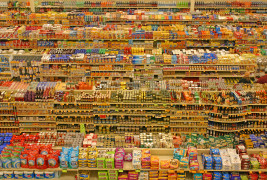A Land with too Much Plenty: Food Collapse and Florida’s Future
Not Feeling the Pinch in the Land of More Than Enough,
Joel Bourne’s The End Of Plenty, Food Collapse and the Florida Future
Editorial: Ecology Florida
Did you get enough to eat yesterday? For folks reading this article, the answer is probably “yes.” “Yes, thank you, more than enough.”
In America when it comes to food, like just about everything else, we have enough, and more than enough. We have enough cell phones, computers, cars, dress shoes, cool homes in climate-change summers, cool playlists on iphones, skirts, running shoes, pets, posters, vacation plans, work pants, house plants, business cards, microwave ovens, logo t-shirts – enough, and more than enough.
We certainly have enough food – at least in America, at least for now.
Nearing the End – At Least of Plenty
This is not true in other parts of the world, and those other parts of the world are growing – apparently quite quickly. According to Joel Bourne, author of the just published, The End of Plenty, we are nearing the point of food collapse – i.e., insufficient food supplies to feed large numbers of the planet’s human residents.
Many factors are contributing to the planet’s food collapse, and most are either not well known or of little concern to Americans. Bourne tells us plenty about these factors in The End of Plenty. As observed by Dave Davies of National Public Radio’s Fresh Air:
While the Earth’s population is growing rapidly, our ability to feed it is undermined by a loss of arable land due to climate change, growing water shortages, the use of valuable farmland to grow biofuels and the fact that many of us eat so much meat, which is a highly inefficient way to use the grain we grow. [6]
Bourne’s Pinch
These factors are not news to readers of ECFL News, which has editorialized on this topic from time to time – first in 2012, in “Dining and Dreaming at the Top of The World.”[3] Bourne reminds us of what we already know, but which many others do not – at least many who are still dining at the top of the world. He tells us that:
Here in the United States, we’ve had 2012-2013, you know, we had the worst drought since the Dust Bowl days – cost us $30 billion. So – and what we’re dealing with is sort of the new normal. You know, the researchers say that now we’re going to have to, because of the increased demand from population growth, increased meat consumption in developing parts of the world, that we’re going to have to double our grain production, our food production, by 2050 to make sure everyone’s reasonably fed. And yet, climate change is just starting to really hammer it down, so we’re in a bit of a pinch. [6]
All right, Joel! A bit of pinch indeed. We are not feeling it – not yet. It is still too easy for us to get food (or substance that passes for food). Food is inexpensive in America. It is also easily accessible. And so Joel’s bit-of-a-pinch is not being felt by most, and hardly at all by leaders who could be making a difference.
Here is another pinch we are not yet feeling, and of which our leaders appear oblivious: “we’re looking at having to grow as much food in the next forty years as we have since agriculture began 10,000 years ago. It is the greatest challenge that humanity has ever faced, and we have to do it without destroying the water, the oceans, the soils, that we all depend on. It’s just – it’s a staggering challenge.” [6]
Two Places to Watch
In the near future, we may begin to see what this challenge looks like, and start to feel a bit of Bourne’s pinching. The two places to watch are California and the American Midwest. These are major food production centers for the world, and certainly for the US. California is currently experiencing one of the worst droughts in its history, at the same time that the state has become the source for vast quantities of fruits and vegetables.
Much is being made in the skeptical media that this is not the “worst drought” in California’s history. It apparently is not. What is certain, however, is that it is indeed the worst drought in California’s history since the state became the primary supplier for most of the nation’s fresh fruits and vegetables. Climate Progress tells us:
Eaten a salad recently? Odds are the lettuce, carrots, and celery came from California. Have a soft spot for stone fruit? California produces 84 percent of the country’s fresh peaches and 94 percent of the country’s fresh plums. It produces 99 percent of the artichokes grown in the United States, and 94 percent of the broccoli. As spring begins to creep in, almost half of asparagus will come from California. [2]
The odds are pretty good, even in Florida, that these fruits and vegetables are coming from California, despite the fact that Florida can grow them all, and do so with less stress on the environment. Ironically, in the midst of this stunning drought, California is exporting vast quantities of water – in the form of fruits and vegetables. Here in Florida, we can grow a multitude of fruits and vegetables year round, and we still have pretty good water supplies, but we support further drawdown of California’s water table by importing California water in the form of California produce. Needless to say, Floridians are also financially supporting Big Ag’s exploitation of California’s water and other natural resources with every purchase of California produce that we make. We can do better than that as a state and a nation. See our earlier editorial, “We Can Do Better Than California Broccoli.”[4]
Meanwhile, in the Midwest, the Ogallala Aquifer continues being over pumped to support industrial agriculture in the midst of a drought, as noted by Bourne (above), and produce grains for livestock, bio-fuels, and some human consumption. As with California’s fruits and vegetables, the American Midwest is still producing grain at a remarkable clip. In both cases the production is occurring at a considerable (and largely hidden) cost – the depletion of water reserves. But the water has not run out in California or in the Midwest, and so the only pinch we feel is a rhetorical one.
Ask Folks You Know
Ask folks you know if they are aware of the California drought and how it relates to our getting enough (and more than enough) to eat. Ask them if they are even aware of the rapid depletion of water supplies for the “breadbasket of the world” – you don’t need to use the word Ogallala. Most will not be aware of what is happening. Why should they? They have enough and more than enough, and so do we all in America, in the restaurant at the top of the world, where food travels an average of 1500 miles to reach our plates and we can wash down our Chilean Sea Bass with some Sapporo Premium beer in air-conditioned comfort during the hottest year on record.
Hopefully, we’ll resolve our food policy challenges before the end of plenty becomes a reality – and we really feel the pinch. If we don’t, we may be in for a lot more than a pinch.
Sources: Those Cited and Others For Further Reading
[1] Joel Bourne, “The Global Food Crisis”
[2] Climate Progress, “California’s Drought Could Upend America’s Entire Food System”
[3] Ecology Florida, “Editorial: Dining and Dreaming at the Top of the World”
[4] Ecology Florida, “Editorial: We Can Do Better Than California Broccoli”
[5] Kirkus, “Kirkus Review: The End of Plenty”
[6] NPR, Fresh Air, “As Global Population Grows, Is The Earth Reaching the End of Plenty?


Leave a Reply